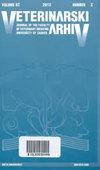The prevalence, antibiotic resistance and biofilm formation ability of Enterococcus spp. isolated from food products in Algeria
IF 0.3
4区 农林科学
Q4 VETERINARY SCIENCES
引用次数: 0
Abstract
Enterococci are ubiquitous bacteria in the normal intestinal microbiota of both humans and animals. They can be used in the food industry as starter or probiotic cultures. However, some species have emerged as an important nosocomial pathogens, and have been implicated in severe multi-resistant infections. In this study, a total of 235 food products were analyzed for the presence of Enterococcus spp. Overall, 54 (22.9%) out of the 235 samples were contaminated and 54 strains were isolated. The latter were identified by matrix assisted laser desorption/ionization time-of-flight mass spectrometry (MALDI-TOF MS) and tested for antibiotic susceptibility against seven antibiotic molecules, in addition to their ability to form a biofilm. The predominant species was Enterococcus faecalis (70.4%), followed by Enterococcus hirae (12.9%), Enterococcus faecium (11.1%) and Enterococcus durans (5.5%). The highest resistance profile was ascribed to tetracycline (66.7%) and penicillin G (33.3%). Six enterococcal isolates (11.1%) were resistant to at least three antibiotic families. All isolated strains were able to form a biofilm and exhibited gelatinase activity. However, only 4 (7.4%) were β-hemolytic. This study revealed that food products might play a role in the spread of enterococci through the food chain to humans with these virulence and resistance characteristics. As a result, continuous investigations are necessary to assess the health hazards associated with the consumption of contaminated food products.阿尔及利亚食品分离肠球菌流行率、抗生素耐药性和生物膜形成能力
肠球菌是人类和动物正常肠道菌群中普遍存在的细菌。它们可以在食品工业中用作发酵剂或益生菌培养物。然而,一些物种已成为重要的医院病原体,并已涉及严重的多重耐药感染。本研究共对235份食品进行了肠球菌检出分析,其中54份(22.9%)被污染,分离出54株。后者通过基质辅助激光解吸/电离飞行时间质谱(MALDI-TOF MS)鉴定,并测试了对7种抗生素分子的抗生素敏感性,以及它们形成生物膜的能力。优势菌种为粪肠球菌(70.4%),其次为扁平肠球菌(12.9%)、屎肠球菌(11.1%)和杜兰肠球菌(5.5%)。耐药性最高的是四环素(66.7%)和青霉素G(33.3%)。6株肠球菌(11.1%)对至少3个抗生素家族耐药。所有分离菌株均能形成生物膜,并表现出明胶酶活性。然而,只有4例(7.4%)为β-溶血。该研究表明,具有这些毒力和耐药性特征的食品可能在肠球菌通过食物链传播给人类的过程中发挥作用。因此,有必要进行持续调查,以评估与食用受污染食品有关的健康危害。
本文章由计算机程序翻译,如有差异,请以英文原文为准。
求助全文
约1分钟内获得全文
求助全文
来源期刊

Veterinarski Arhiv
VETERINARY SCIENCES-
CiteScore
0.80
自引率
20.00%
发文量
22
审稿时长
6-12 weeks
期刊介绍:
The journal Veterinarski arhiv (Vet. arhiv) publishes original scientific papers, case reports, short communications, review papers and book reviews. Occasionally, in supplemental issues, it publishes papers of relevant conferences. The scope of the journal includes all fields of veterinary and animal sciences. Veterinarski arhiv is published by the Faculty of Veterinary Medicine University of Zagreb, six times a year, as an open access, peer-reviewed, international scientific journal. Only unpublished manuscripts may be accepted for the review process. All papers must be written in English and submitted via the Journal''s online submission system (COMET). The content of the Journal is available free of charge and there are no publication charges.
 求助内容:
求助内容: 应助结果提醒方式:
应助结果提醒方式:


